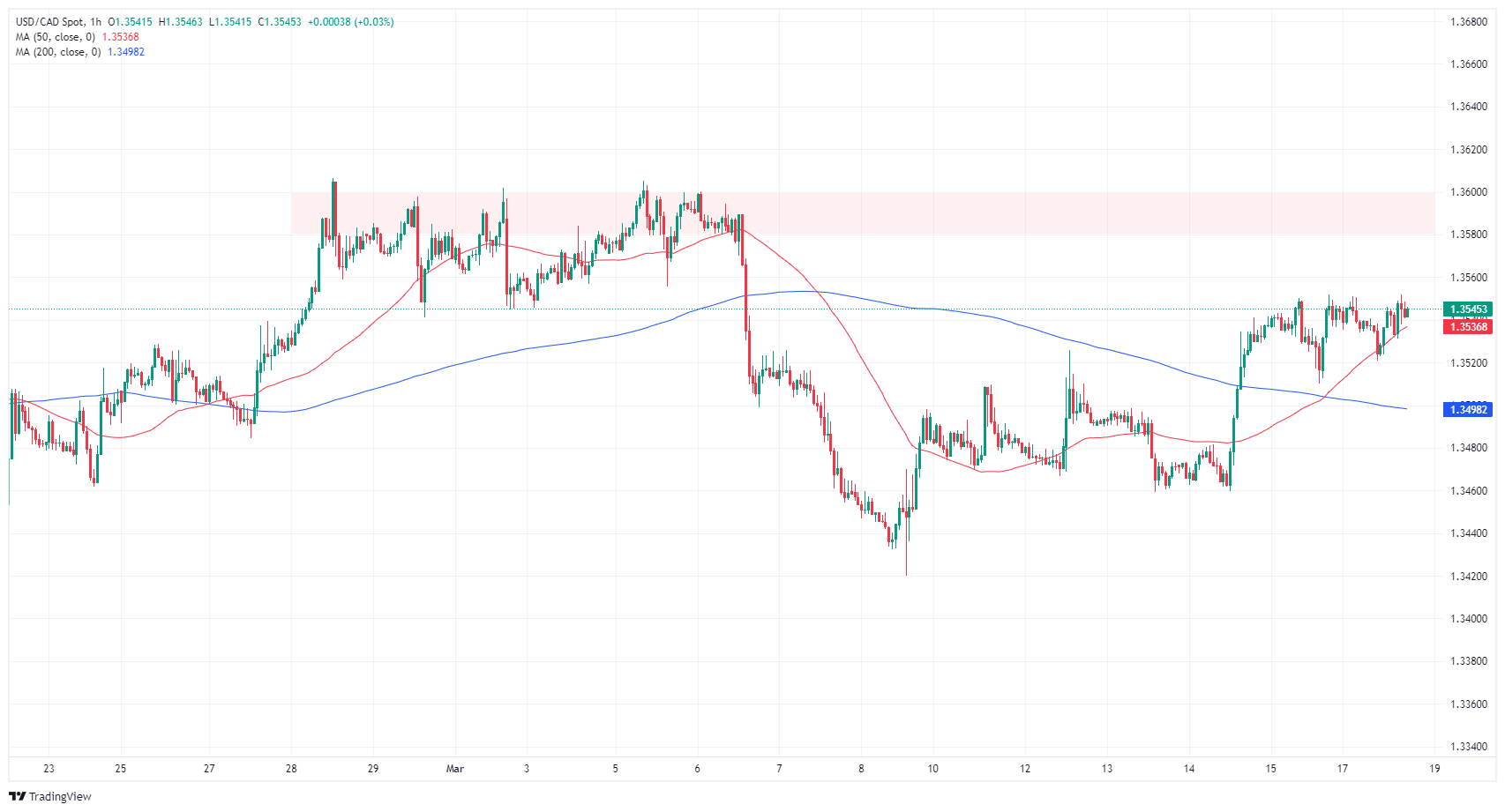- The Canadian Dollar finds little momentum on the charts as investors prepare for a busy week.
- The Canadian CPI is the first data on the agenda, and is expected to rise on Tuesday.
- On Wednesday, the Fed will announce interest rates and update the dot chart.
He Canadian dollar (CAD) is sifting chart paper Monday, easing into the trading week as investors take a moment to breathe before a week full of central banks begins in earnest. The Federal Reserve (Fed) is expected to update its interest rate forecast summary, or dot charts, on Wednesday. Figures from the US Purchasing Managers' Index (PMI) will also be published on Thursday.
Canada is the first country of the week, with an update on the Consumer Price Index (CPI) inflation in February. On Wednesday, the Bank of Canada (BoC) will update its summary of deliberations, shadowing the Federal Open Market Committee's (FOMC) midweek press conference.
Daily Market Moves Summary: Canadian Dollar Steady as Investors Wait for Spark from Central Banks
- The Canadian Commodity Price Index and Industrial Product Prices for February were released with little impact.
- Canadian commodity prices rose 2.1% in February, a five-month high and a sharp increase from the previous 1.2%.
- Prices of industrial products rose 0.7% in February, compared to -0.1% the previous month, the largest increase in the last six months.
- Canadian February CPI inflation is expected to rise on Tuesday, forecast at 3.1% year-over-year versus 2.9% previously.
- Canadian CPI month-on-month inflation is expected to rebound to 0.6% from 0.0% previously.
- The BoC's core CPI inflation was 2.4% in January, the lowest since May 2021.
- Wednesday is another FOMC day. Updates to the Fed's dot chart are expected, as well as a press conference from Fed Chair Jerome Powell.
- According to CME's FedWatch tool, rates markets are almost evenly pricing the odds of no rate cut at the Fed's June rate call, down significantly from the 70% chance of a June rate cut this time last week.
Current price of the Canadian Dollar
The following table shows the percentage change of the Canadian Dollar (CAD) against the main currencies. The Canadian dollar was the weakest currency against the Australian dollar.
| USD | EUR | GBP | CAD | AUD | JPY | NZD | CHF | |
| USD | 0.04% | 0.05% | -0.01% | -0.02% | 0.15% | 0.06% | 0.35% | |
| EUR | -0.05% | 0.01% | -0.05% | -0.03% | 0.12% | 0.03% | 0.28% | |
| GBP | -0.05% | 0.00% | -0.05% | -0.03% | 0.12% | 0.03% | 0.29% | |
| CAD | 0.01% | 0.05% | 0.05% | -0.02% | 0.15% | 0.07% | 0.33% | |
| AUD | 0.02% | 0.07% | 0.07% | 0.00% | 0.17% | 0.08% | 0.35% | |
| JPY | -0.16% | -0.12% | -0.05% | -0.16% | -0.17% | -0.08% | 0.18% | |
| NZD | -0.06% | -0.03% | -0.03% | -0.06% | -0.06% | 0.09% | 0.27% | |
| CHF | -0.33% | -0.30% | -0.30% | -0.35% | -0.32% | -0.17% | -0.27% |
The heat map shows the percentage changes of the major currencies against each other. The base currency is chosen in the left column, while the quote currency is chosen in the top row. For example, if you choose the euro in the left column and scroll down the horizontal line to the Japanese yen, the percentage change in the box will represent EUR (base)/JPY (quote).
Technical Analysis: Canadian Dollar Turns in Place on Monday, USD/CAD Remains Oscillating Just Below 1.3550
The Canadian Dollar (CAD) is flat against most major currencies on Monday as markets begin the new trading week. Against the US Dollar (USD), the Euro (EUR), the British Pound (GBP), the Australian Dollar (AUD) and the New Zealand Dollar (NZD), the CAD remains virtually stable. Despite flat markets, the Canadian Dollar rose about a third of a percentage point against the Swiss Franc (CHF) on the day.
The USD/CAD pair is trading at known technical levels, just below 1.3550. Intraday technical support is located in the 1.3500 area, parked at the 200 hourly simple moving average (SMA). A short-term supply zone lies between 1.3600 and 1.3580 to cut off any bullish breakout.
USD/CAD Hourly Chart
Canadian Dollar FAQ
The key factors that determine the rate of the Canadian dollar (CAD) are the level of interest rates set by the Bank of Canada (BoC), the price of oil, Canada's largest export product, the health of its economy, inflation and the trade balance, which is the difference between the value of Canadian exports and its imports. Other factors are market sentiment, that is, whether investors bet on riskier assets (risk-on) or look for safe havens (risk-off), with the risk-on being positive for the CAD. The health of the US economy, its largest trading partner, is also a key factor influencing the Canadian dollar.
The Bank of Canada (BoC) exerts significant influence on the Canadian dollar by setting the level of interest rates that banks can lend to each other. This influences the level of interest rates for everyone. The BoC's main objective is to keep inflation between 1% and 3% by adjusting interest rates up or down. Relatively higher interest rates are usually positive for the CAD. The Bank of Canada can also use quantitative easing and tightening to influence credit conditions, with the first being negative for the CAD and the second being positive for the CAD.
The price of oil is a key factor influencing the value of the Canadian dollar. Oil is Canada's main export, so the price of oil tends to have an immediate impact on the value of the CAD. Generally, if the price of oil rises, the CAD also rises, as aggregate demand for the currency increases. The opposite occurs if the price of oil falls. Higher oil prices also tend to lead to a higher probability of a positive trade balance, which is also supportive for the CAD.
Although inflation has traditionally always been considered a negative factor for a currency, since it reduces the value of money, the truth is that in modern times the opposite has happened with the relaxation of cross-border capital controls. Inflation tends to lead central banks to raise interest rates, which attracts more capital from investors around the world looking for a lucrative place to store their money. This increases the demand for the local currency, which in the case of Canada is the Canadian dollar.
The release of macroeconomic data measures the health of the economy and can influence the Canadian dollar. Indicators such as GDP, manufacturing and services PMIs, employment and consumer sentiment surveys can influence the direction of the CAD. A strong economy is good for the Canadian dollar. Not only does it attract more foreign investment, but it may encourage the Bank of Canada to raise interest rates, resulting in a stronger currency. However, if economic data is weak, the CAD is likely to fall.
Source: Fx Street
I am Joshua Winder, a senior-level journalist and editor at World Stock Market. I specialize in covering news related to the stock market and economic trends. With more than 8 years of experience in this field, I have become an expert in financial reporting.






